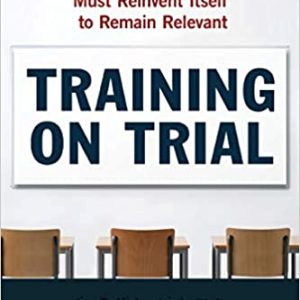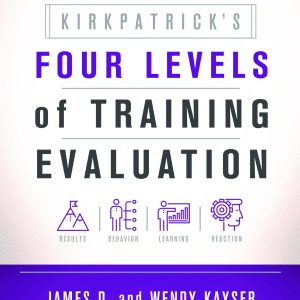Kirkpatrick Then and Now: A Strong Foundation For the Future
Order NowAlso available at these retailers
The Kirkpatrick Four Levels is 50 Years New
The Kirkpatrick Model was first published in November 1959. Since then, it has become the standard for evaluation in the training industry. It has also been widely misunderstood. On the anniversary of the Four Levels, Kirkpatrick Then and Now will provide the accurate, timely, and valuable information training professionals seek.
Read the original four articles
The four articles that established the terms Reaction, Learning, Behavior, and Results are included in the book exactly as they were originally published in 1959.
Discover the true story behind the Kirkpatrick Four Levels
Don Kirkpatrick himself tells the story, assisted by others, such as Jack Phillips, who were key in the growth of the model. Historical photos and quotes from industry experts are also included.
Learn the Kirkpatrick Foundational Principles
This is the most detailed explanation available of the key ideas that underpin and modernize the original Kirkpatrick Four Levels. These principles outline the true, complete model that encompasses the entire learning process, including (but not limited to) evaluation.
See the Kirkpatrick Business Partnership Model in a step-by-step format
This model guides you through all stages of training and development with sound Kirkpatrick logic.
The Kirkpatrick Four Levels is 50 Years New
The Kirkpatrick Model was first published in November 1959. Since then, it has become the standard for evaluation in the training industry. It has also been widely misunderstood. On the anniversary of the Four Levels, Kirkpatrick Then and Now will provide the accurate, timely, and valuable information training professionals seek.
Read the original four articles
The four articles that established the terms Reaction, Learning, Behavior, and Results are included in the book exactly as they were originally published in 1959.
Discover the true story behind the Kirkpatrick Four Levels
Don Kirkpatrick himself tells the story, assisted by others, such as Jack Phillips, who were key in the growth of the model. Historical photos and quotes from industry experts are also included.
Learn the Kirkpatrick Foundational Principles
This is the most detailed explanation available of the key ideas that underpin and modernize the original Kirkpatrick Four Levels. These principles outline the true, complete model that encompasses the entire learning process, including (but not limited to) evaluation.
See the Kirkpatrick Business Partnership Model in a step-by-step format
This model guides you through all stages of training and development with sound Kirkpatrick logic.
Testimonials
Stephen R. Covey – Author, 7 Habits of Highly Effective People and The Leader in Me
“Kirkpatrick’s four levels is the best I’ve ever seen in evaluating training effectiveness. It is sequentially integrated and comprehensive. It goes far beyond ‘smile sheets’ into actual learning, behavior changes and actual results, including long-term evaluation. An outstanding model!”
Excerpt from the book
(From pp. 108-109)
Build Evaluation Elements into the Training Program
As you build the training program, weave in elements of evaluation along the way. Facilitators should be able to explain to participants the importance of what they are learning, how it is to be applied on the job, and what methods will be used to support and measure it during and after class. Reminding participants what is expected of them after class sets the stage for good learning during class and execution of key behaviors afterwards. It is also important to inform participants what will be measured and how, so there is no surprise or discomfort as a result. It is important to do this in the spirit of caring and helpfulness.
Make sure that Level 3 support is as integrated into your training program as possible. For example, have the facilitator introduce key job aids, and have participants use them to complete activities during class. During the instructional design process, go ahead and design any follow-up communication and refreshers you plan to use. You could even consider having participants register for lunch and “learn” or other refresher training events if you plan to hold them. Turn the “old” style trainer objection that, “we only have control at Levels 1 and 2,” into “We have great control at Levels 1 and 2, so we will leverage that time to make the most impact we can at Levels 3 and 4.”
Keep in mind that the Kirkpatrick Four Levels reflect more than an evaluation plan. When you get to Level 3 you also want to consider which drivers need top support, reinforcement, and rewards in terms of what you plan. Again, you want to build as much of that into your training program as possible so these things are ready and in place when training participants have completed the class. This will be greatly appreciated by the managers and supervisors who will be “passed the baton,” if you will when the training graduates return to the job and need to perform the behaviors they just learned about.
Keep the evidence your jury wants to see (and in what form) in mind as you design the course. It’s good practice to build any necessary evaluation or tracking tools during the instructional design process to ensure that they complete, and fully align with the objectives. How many times have we heard training professionals on the evening before the launch of a new class, say, “Oops, I forgot to make my reaction sheet.” Leaving evaluation methods as afterthoughts like this will not support return on expectations (ROE).
Make sure during the design and development of the program you sketch out your intended Chain of Evidence. Make sure you would believe it if it was presented to you. Share the concept with your key stakeholders and find out if they will believe it if you indeed are able to deliver it to them. Better to find out in the development stage if your evidence is going to be credible to the jury or not!











Reviews
There are no reviews yet.